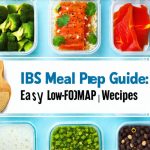Gastroesophageal reflux disease (GERD) and irritable bowel syndrome (IBS) frequently coexist, creating a challenging landscape for individuals seeking dietary relief. Often, those managing both conditions find that dietary recommendations for one exacerbate the other, leading to frustration and a constant struggle with digestive discomfort. This is because GERD, characterized by stomach acid flowing back into the esophagus, often triggers symptoms when consuming foods that also aggravate IBS – a functional gastrointestinal disorder impacting the large intestine. Navigating this complex interplay requires a nuanced approach to meal planning, focusing on reducing overall gut irritation while identifying individual trigger foods.
The key lies in understanding that both conditions are highly individualized. While general guidelines exist, what triggers symptoms for one person may not affect another. This weekly meal plan is designed as a starting point, offering a framework built upon low-FODMAP principles (beneficial for IBS) and GERD-friendly choices – prioritizing bland, easily digestible foods while minimizing acid production and bloating. It emphasizes smaller, more frequent meals rather than large portions, and encourages careful monitoring of individual tolerances to refine the plan over time. Remember, consulting with a registered dietitian or healthcare professional is crucial for personalized guidance tailored to your specific needs and medical history. If you’re struggling to manage both conditions simultaneously, exploring resources like meal organization techniques can be incredibly beneficial.
Understanding the Interplay: GERD & IBS Dietary Considerations
The connection between GERD and IBS isn’t fully understood, but several theories exist. One prevailing idea suggests that chronic inflammation in one area of the digestive tract can contribute to sensitivity and dysfunction in another. For example, frequent acid reflux from GERD may irritate the gut lining, potentially triggering IBS symptoms or worsening existing sensitivities. Conversely, increased intestinal permeability (often associated with IBS) might allow more stomach acid to reach the esophagus, exacerbating GERD. This bidirectional relationship highlights the need for a holistic dietary approach that addresses both conditions simultaneously.
Dietary strategies for GERD typically focus on reducing acid production and minimizing esophageal irritation. This includes avoiding trigger foods like caffeine, alcohol, chocolate, fatty foods, spicy foods, citrus fruits, tomatoes, and carbonated beverages. For IBS, the low-FODMAP diet is often recommended, restricting fermentable carbohydrates that can cause gas, bloating, and abdominal pain. These FODMAPs include lactose (dairy), fructose (fruits and honey), fructans (wheat, onions, garlic), galactans (legumes), and polyols (sugar alcohols). Combining these approaches requires careful consideration—many GERD triggers can also be high-FODMAP foods, necessitating creative substitutions and mindful portion control. Planning ahead is crucial; consider how to create a weekly GERD meal prep plan to streamline your efforts.
The goal isn’t about strict elimination but rather intelligent reduction. Identifying personal tolerances is paramount. Food diaries are invaluable tools for tracking what you eat and how it affects your symptoms. Over time, this process helps pinpoint trigger foods and allows for a more personalized, sustainable dietary plan that minimizes discomfort and improves overall digestive health. It’s also important to remember the role of stress management and lifestyle factors (sleep, exercise) in both GERD and IBS symptom control; diet is just one piece of the puzzle. For those experiencing chronic fatigue alongside these conditions, meal planning can become even more challenging, but also incredibly rewarding for overall wellbeing.
Weekly Meal Plan: A Starting Point
This meal plan provides a sample structure for seven days, focusing on easily digestible foods and minimizing common triggers. It’s designed to be adaptable – swap meals based on your preferences and tolerances, and adjust portion sizes as needed. Remember to drink plenty of water throughout the day, avoiding large volumes with meals to prevent bloating. Portion control is key; smaller, more frequent meals are generally better tolerated than larger ones.
Monday: Breakfast: Oatmeal (made with almond milk) topped with blueberries and a sprinkle of chia seeds. Lunch: Grilled chicken salad with mixed greens, cucumber, and olive oil vinaigrette. Dinner: Baked salmon with roasted sweet potatoes and steamed green beans. Tuesday: Breakfast: Scrambled eggs with spinach and whole-wheat toast. Lunch: Turkey breast sandwich on gluten-free bread with lettuce and avocado. Dinner: Chicken and vegetable stir-fry (using low-FODMAP vegetables like carrots, bell peppers, and zucchini) served with brown rice. Wednesday: Breakfast: Yogurt (lactose-free if needed) with a small amount of sliced banana and walnuts. Lunch: Leftover chicken and vegetable stir-fry. Dinner: Lean ground beef and potato shepherd’s pie (using lactose-free mashed potatoes). Thursday: Breakfast: Smoothie made with almond milk, spinach, banana, and protein powder. Lunch: Tuna salad (made with mayonnaise) on gluten-free crackers. Dinner: Baked cod with roasted asparagus and quinoa. Friday: Breakfast: Rice porridge with cinnamon and applesauce. Lunch: Leftover baked cod and vegetables. Dinner: Chicken soup (homemade with low-FODMAP ingredients). Saturday: Breakfast: Gluten-free pancakes with maple syrup and blueberries. Lunch: Salad with grilled shrimp, avocado, and a lemon vinaigrette. Dinner: Roasted chicken breast with mashed sweet potatoes and broccoli. Sunday: Breakfast: Eggs Benedict on gluten-free English muffins (using lactose-free hollandaise sauce). Lunch: Leftover roasted chicken and vegetables. Dinner: Turkey meatballs with zucchini noodles and tomato sauce (use a low-acid tomato sauce).
Navigating Common Triggers
- Fatty Foods: High-fat foods can relax the lower esophageal sphincter, increasing the risk of acid reflux in GERD sufferers. They also slow down digestion, potentially exacerbating IBS symptoms. Choose lean protein sources and healthy fats in moderation.
- Spicy Foods: Capsaicin, found in spicy foods, can irritate the esophagus and stimulate acid production. For those with IBS, it can also cause diarrhea or abdominal cramping. Limit or avoid spicy foods altogether.
- Acidic Foods: Citrus fruits, tomatoes, and vinegar-based dressings can trigger GERD symptoms. While some individuals may tolerate small amounts, it’s best to monitor your response and adjust accordingly.
- Carbonated Beverages: These drinks increase stomach pressure, potentially leading to acid reflux. They also introduce gas into the digestive system, which can worsen IBS bloating. Opt for water or herbal teas instead.
Meal Preparation & Planning Tips
- Batch Cooking: Prepare large portions of staples like rice, quinoa, and roasted vegetables on the weekend to save time during the week.
- Grocery Shopping: Create a detailed grocery list based on your meal plan to avoid impulse purchases of trigger foods.
- Food Diary: Maintain a food diary to track what you eat and how it affects your symptoms. This will help you identify personal triggers and refine your dietary plan over time.
- Mindful Eating: Eat slowly and chew thoroughly to aid digestion. Avoid eating large meals, especially before bedtime.
- Hydration: Drink water throughout the day, but avoid drinking too much during mealtimes as it can potentially lead to bloating. For busy professionals, a gut-friendly meal plan can be a lifesaver.
Long-Term Management & Considerations
Living with GERD and IBS requires ongoing management, not just a temporary dietary change. The weekly meal plan is merely a starting point; consistent monitoring of your body’s response to different foods is crucial. Consider working with a registered dietitian who specializes in gastrointestinal disorders. They can provide personalized guidance based on your individual needs and help you navigate the complexities of managing both conditions simultaneously. Don’t be afraid to experiment within safe boundaries, gradually reintroducing foods that you’ve eliminated to see if your tolerance has improved over time. Remember, consistency is key, and a proactive approach to dietary management can significantly improve your quality of life. If nausea is a frequent issue, exploring a gentle meal plan could be beneficial. Planning ahead with a weekly GERD meal prep plan can also help streamline the process and ensure you’re consistently making gut-friendly choices. Finally, consider how to create a gut-healthy meal plan using seasonal ingredients for variety and optimal nutrition.


















